#now that i'm thinking about this sepia tabbies are quite pale too
Explore tagged Tumblr posts
Text
A, B, C, D, E - Cat vs Rabbit
My comparative cat and rabbit color genetics post
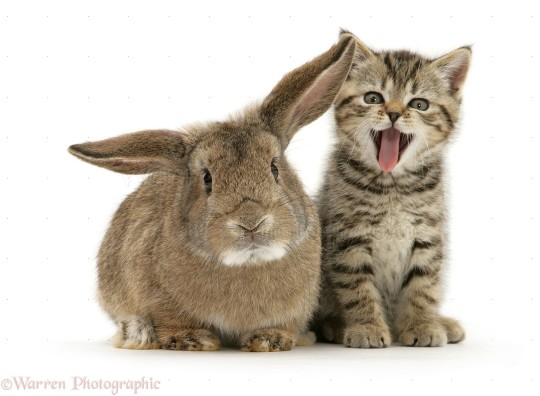
Wild type (black agouti) rabbit and cat
My color genetics interest started out with rabbits, and while I know much more about cats now, they'll always have a spot in my heart...
In this post I'll go through the most important color genes, although sometimes I'll make comparisons based on phenotypes too.
All the photos are from the Warren Photographic Image Library.
A. Agouti
Both species have the dominant agouti (A) and the recessive self or nonagouti (a) alleles.
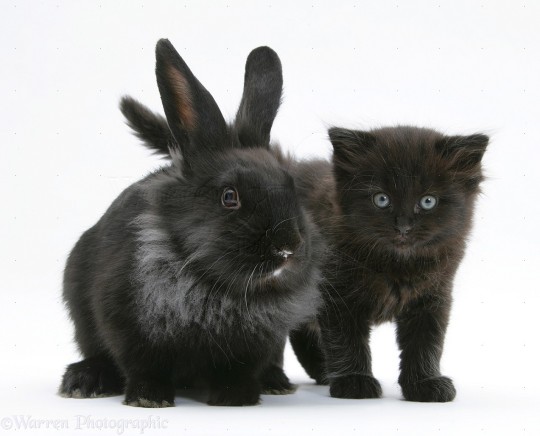
Black self rabbit and cat
Beyond these, cats add the charcoal (Apb) from the leopard cat, while rabbits have the otter or tan allele (at).
B. Brown
Black (B) as wild type, chocolate (b) as variant for both, and an extra recessive allele for cats: cinnamon (bl).
C. Color restriction
The most dominant allele of the series is the full color (C) for both species.
In rabbits the next is dark chinchilla (cchd), this gives the chinchilla and related colorations. Phenotypically basically the equivalent of silver tabbies in cats, despite silver (I) being a different gene. Chinchilla doesn't show up meaningfully on solid rabbits, so there's no smoke there.

Silver tabby cat and chinchilla rabbit. These are genetically very different colors, but manifest similarly: the animal loses the yellow-red pigments, and keeps the black.
The next rabbit allele in order of dominance is the sable or light chinchilla (cchl) which can be interpreted as the equivalent of sepia/burmese (cb) in cats, although they probably aren't the same mutation, because like the dark chinchilla allele above, sable has "silvering" effect on agoutis. Their shared characteristics are the slightly darker extremities and the intermediate interaction with the point allele.
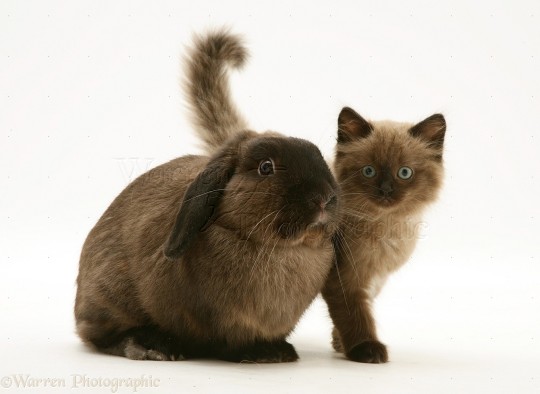
Sable rabbit and sepia (or possibly mink) cat
The colorpoint pattern is also present in both animals under the names siamese (cs) and himalayan (ch). It manifests as pale body with dark extremities.

Pointed cat and rabbit
Edit: unfortunately I made a mistake here: while the color of this rabbit is indeed called point, it's not himalayan, it's nonagouti+sable+red. A real black himalayan rabbit looks like this:

Note the red eyes of the rabbit and the blue eyes of the cat - both suggest depigmentation.
Cats have a rare extra allele called mocha (cm).
And lastly, albino (c) is also present in both.
D. Dilute
Pretty much the same both genetically and in look. Dense (D) is dominant, diluted (d) is recessive.
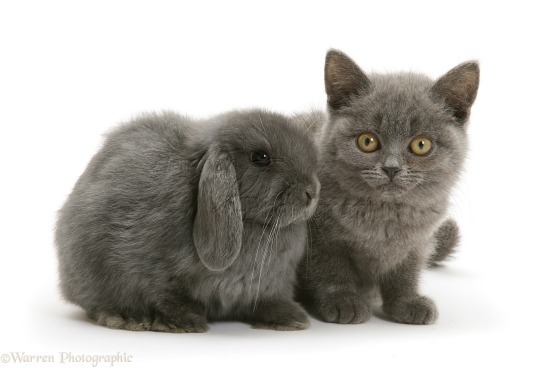
Diluted (blue self) rabbit and cat
E. Extension
The mutations of this gene can be grouped into two categories:
increase of function: overproduction of black pigments. The animal is dark, melanistic. Dominant alleles.
loss of function: underproduction of black pigments. The animal is yellow/red. Recessive alleles.
Rabbits have two dominant alleles in the first group: full extension or dominant black (Ed) and steel (Es); cats have none. (Although this group isn't absent from the cat family either: black jaguars for example have a dominant black mutation.)
In the second group we have lots of different alleles: harlequin or japanese brindle (ej) and red (e) for rabbits, and amber, russet and copal/serdolik for cats (but their red is a different gene!). These all give different reddish phenotypes.
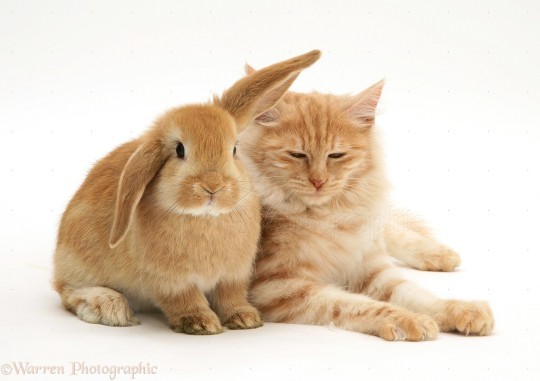
Red rabbit and cat - same name, similar color, different genetics.
The orange gene of the cats is an entirely different matter, and it's just a funny coincidence that harlequin rabbits look so similar to tortie cats. Brindle in rabbits is its own allele, not just the phenotype of the heterozygotes, and it's not sex-linked. Buck rabbits can be harlequins just as easily as does.
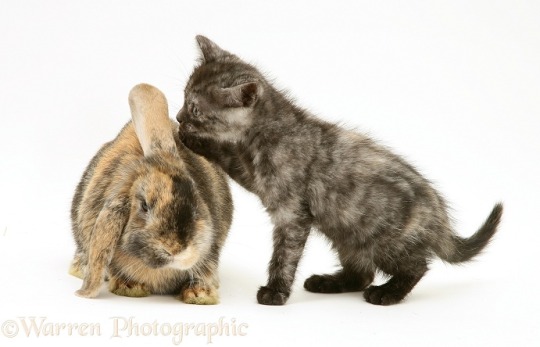
Harlequin rabbit and tortoiseshell cat - similar look, different name, different genetics
To make everything even more complicated, the word "tortoiseshell" (or shortly "tort") is used in rabbit breeding too, but it means a completely different thing than in cats: a nonagouti red. I assume because a nonagouti red rabbit (just like to the genetically very similar nonagouti amber cat) is darker than the agouti counterpart, especially on the extremities.
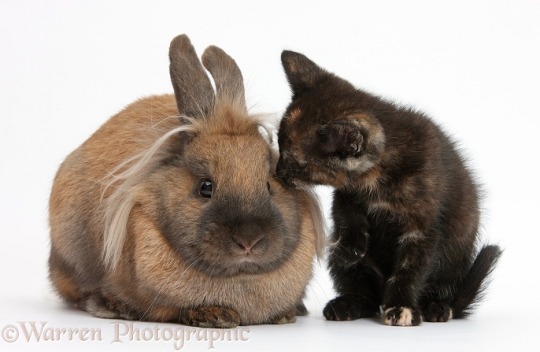
Tortoiseshell rabbit and cat - same name, different look, different genetics: bunny is a recessive homozygote for not sex-linked red, kitten is a heterozygote for sex-linked red.
+1. White spotting
Rabbits have three different white spotting genes: blue-eyed white or viennese, english and dutch. The latter two are strongly linked, the crossing over is rare. It's suspected that all three patterns are caused by mutations on the KIT gene. KIT is also the gene where all the so far known cat white spotting alleles: dominant white, white spotting and white gloving were mapped to.
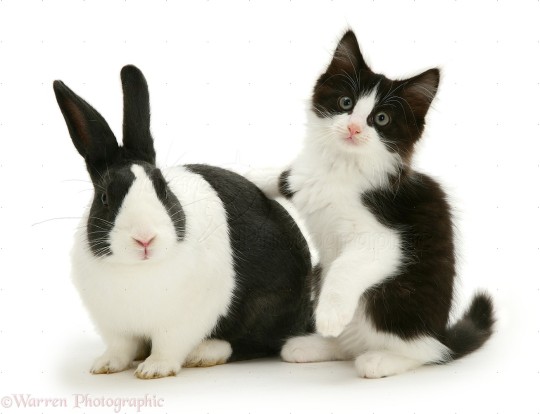
Black dutch rabbit and black bicolor cat. They are remarkably similar, aren't they?
Summary:

#cats#rabbits#cat genetics#rabbit genetics#now that i'm thinking about this sepia tabbies are quite pale too#ugh i love genetics
94 notes
·
View notes